Abstract
Plasminogen activator (PA) is a serine protease existing in two forms known as tissue-type (t-PA) and urokinase-type (u-PA). To examine whether PA is related to the postoperative clinical course of human breast cancer, total PA activity, t-PA activity, u-PA activity, and immunoreactive t-PA were determined in tissue extracts from 144 breast cancer specimens. The patients were initially divided into four groups according to the postoperative clinical course: Group I (83 patients who are disease-free), Group II (20 patients whose first metastases were found only in bone), Group III (19 patients whose first metastases were found in both bone and lung), and Group IV (22 patients whose first metastases were found only in lung). Total PA activity was significantly lower in Groups, II, III and IV than in Group I. Both t-PA activity and t-PA antigen levels were also significantly lower in Groups II, III and IV than in Group I, while no significant difference was found in u-PA activity among these groups, indicating that low activity of total PA in Groups II, III and IV was due to a decrease in t-PA but not in u-PA. In the multivariate analyses, t-PA activity was found to be an independent prognostic factor for relapse-free survival. When four groups of patients were further analysed in terms of nodal status, both t-PA activity and antigen levels were markedly decreased in the node-negative Group II compared with the node-negative Groups III and IV or with the node-positive Groups II, III and IV. Of additional interest, u-PA activity was significantly higher in node-positive patients than in node-negative patients with any group. The clinico-pathologic analyses of the patients in this series showed that node involvement and lymphatic invasion were more frequently positive in Groups III and IV than in Groups I and II. When 144 breast cancers were categorised in terms of combinations of oestrogen receptor (ER) and progesterone receptor (PgR) status, breast cancers which were positive for both receptors were found to contain the highest t-PA activity and antigen. This study provides provocative evidence suggesting a possible differential significance of t-PA and u-PA expression in human breast cancer.
Full text
PDF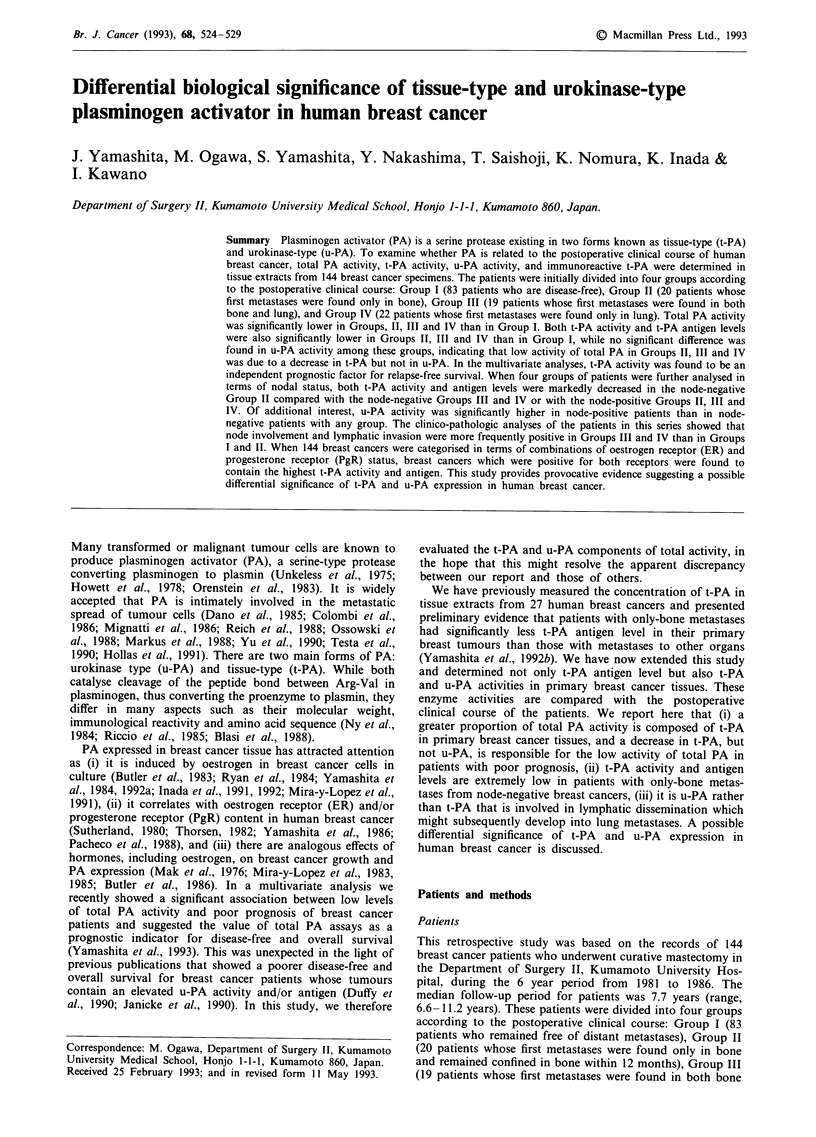
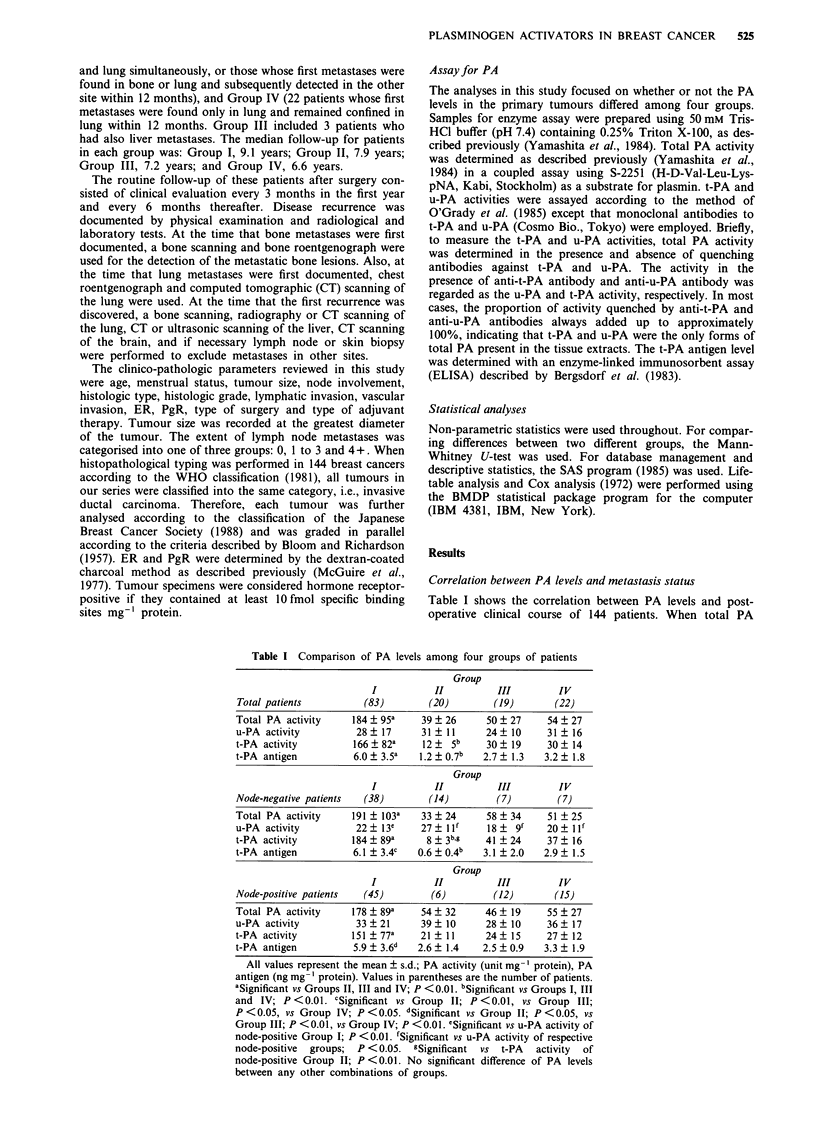
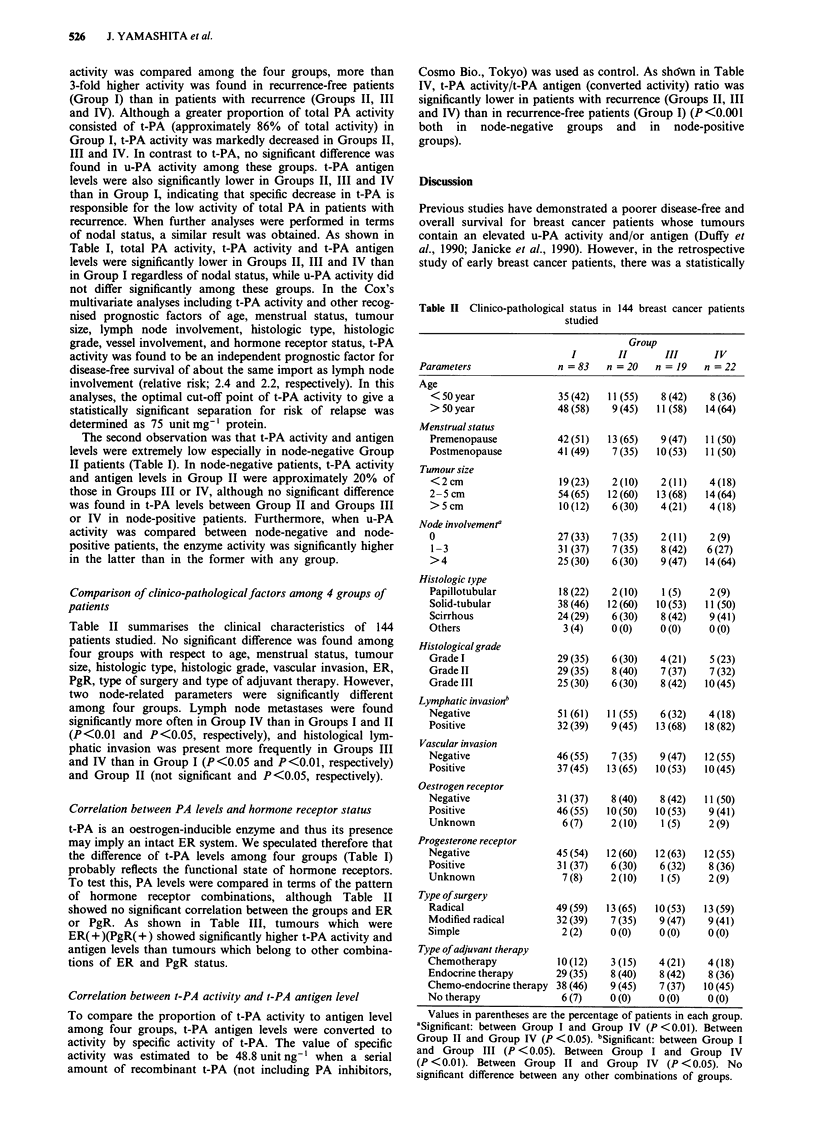
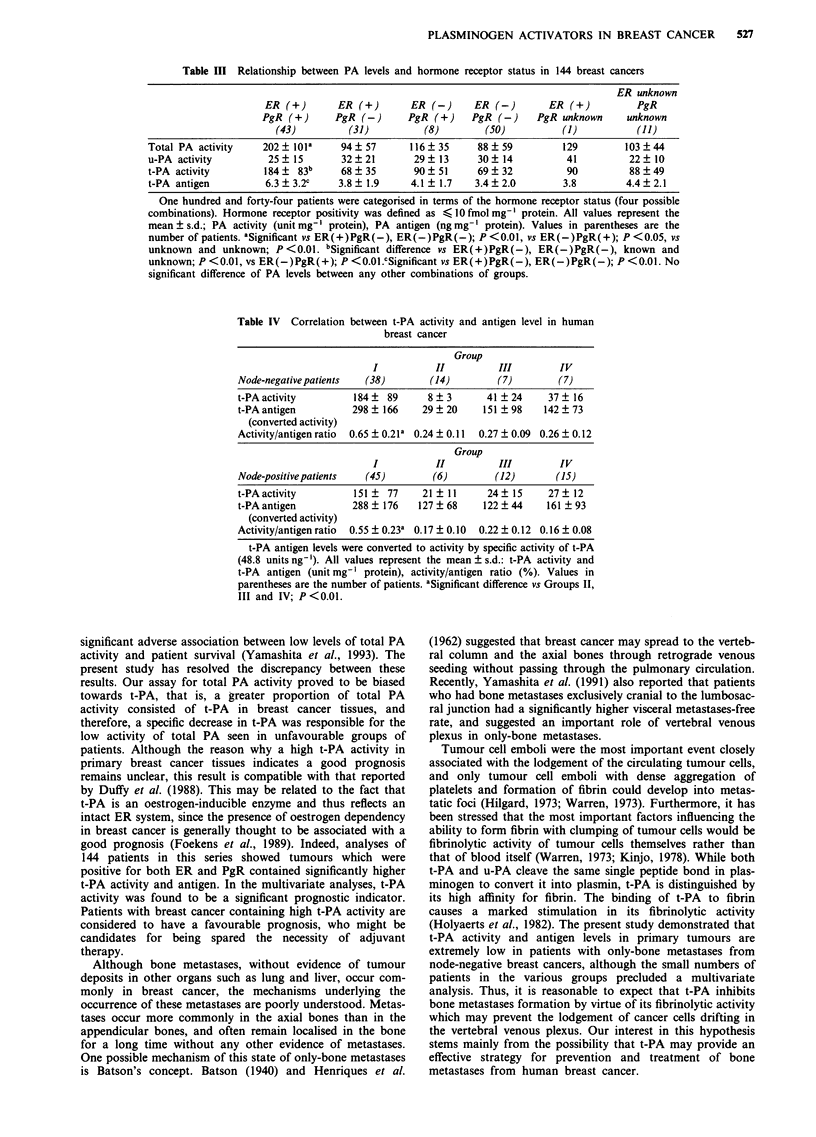
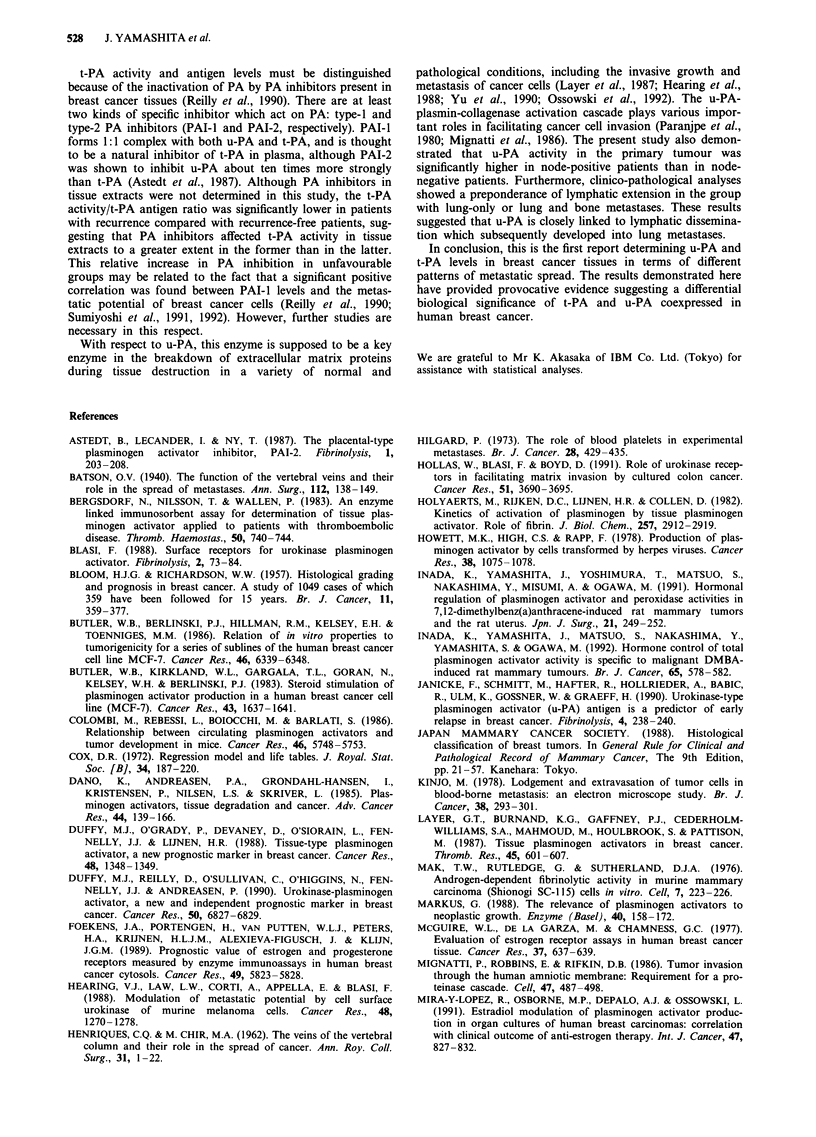
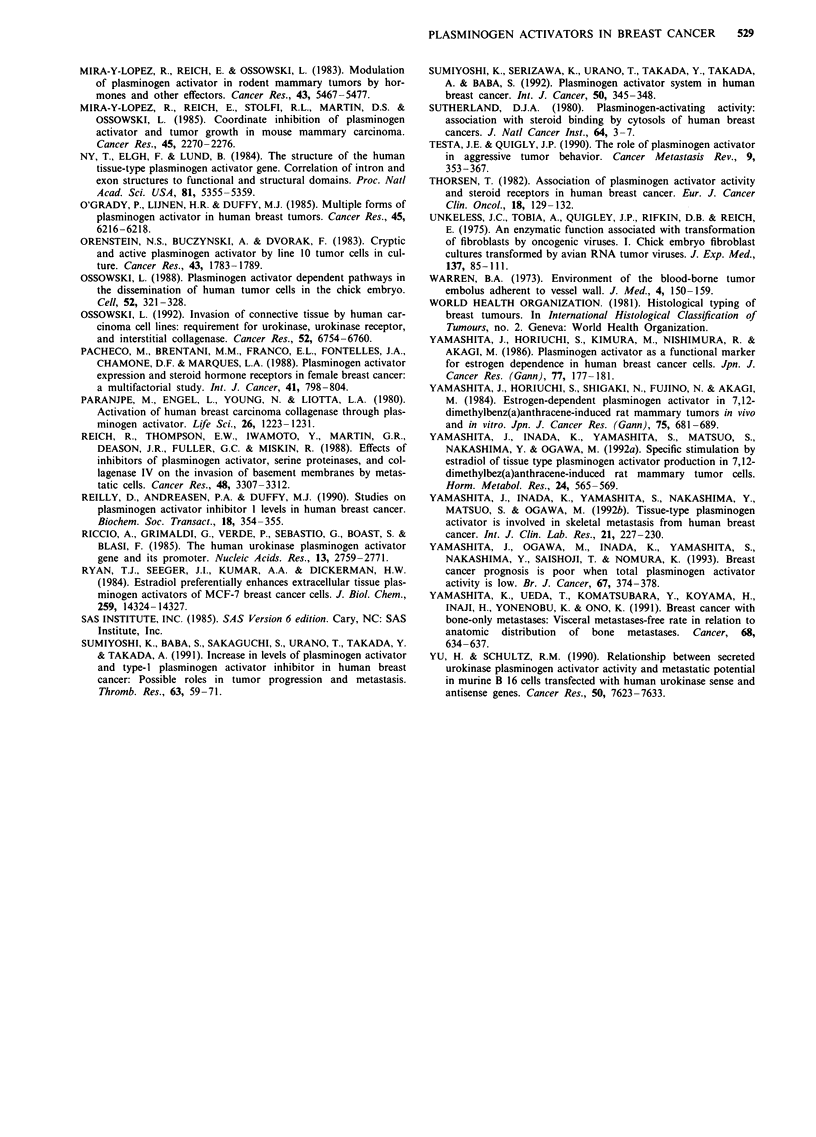
Selected References
These references are in PubMed. This may not be the complete list of references from this article.
- BLOOM H. J., RICHARDSON W. W. Histological grading and prognosis in breast cancer; a study of 1409 cases of which 359 have been followed for 15 years. Br J Cancer. 1957 Sep;11(3):359–377. doi: 10.1038/bjc.1957.43. [DOI] [PMC free article] [PubMed] [Google Scholar]
- Batson O. V. THE FUNCTION OF THE VERTEBRAL VEINS AND THEIR ROLE IN THE SPREAD OF METASTASES. Ann Surg. 1940 Jul;112(1):138–149. doi: 10.1097/00000658-194007000-00016. [DOI] [PMC free article] [PubMed] [Google Scholar]
- Bergsdorf N., Nilsson T., Wallén P. An enzyme linked immunosorbent assay for determination of tissue plasminogen activator applied to patients with thromboembolic disease. Thromb Haemost. 1983 Oct 31;50(3):740–744. [PubMed] [Google Scholar]
- Butler W. B., Berlinski P. J., Hillman R. M., Kelsey W. H., Toenniges M. M. Relation of in vitro properties to tumorigenicity for a series of sublines of the human breast cancer cell line MCF-7. Cancer Res. 1986 Dec;46(12 Pt 1):6339–6348. [PubMed] [Google Scholar]
- Butler W. B., Kirkland W. L., Gargala T. L., Goran N., Kelsey W. H., Berlinski P. J. Steroid stimulation of plasminogen activator production in a human breast cancer cell line (MCF-7). Cancer Res. 1983 Apr;43(4):1637–1641. [PubMed] [Google Scholar]
- Colombi M., Rebessi L., Boiocchi M., Barlati S. Relationship between circulating plasminogen activators and tumor development in mice. Cancer Res. 1986 Nov;46(11):5748–5753. [PubMed] [Google Scholar]
- Danø K., Andreasen P. A., Grøndahl-Hansen J., Kristensen P., Nielsen L. S., Skriver L. Plasminogen activators, tissue degradation, and cancer. Adv Cancer Res. 1985;44:139–266. doi: 10.1016/s0065-230x(08)60028-7. [DOI] [PubMed] [Google Scholar]
- Duffy M. J., O'Grady P., Devaney D., O'Siorain L., Fennelly J. J., Lijnen H. R. Tissue-type plasminogen activator, a new prognostic marker in breast cancer. Cancer Res. 1988 Mar 1;48(5):1348–1349. [PubMed] [Google Scholar]
- Duffy M. J., Reilly D., O'Sullivan C., O'Higgins N., Fennelly J. J., Andreasen P. Urokinase-plasminogen activator, a new and independent prognostic marker in breast cancer. Cancer Res. 1990 Nov 1;50(21):6827–6829. [PubMed] [Google Scholar]
- Foekens J. A., Portengen H., van Putten W. L., Peters H. A., Krijnen H. L., Alexieva-Figusch J., Klijn J. G. Prognostic value of estrogen and progesterone receptors measured by enzyme immunoassays in human breast tumor cytosols. Cancer Res. 1989 Nov 1;49(21):5823–5828. [PubMed] [Google Scholar]
- HENRIQUES C. Q. The veins of the vertebral column and their role in the spread of cancer. Ann R Coll Surg Engl. 1962 Jul;31:1–22. [PMC free article] [PubMed] [Google Scholar]
- Hearing V. J., Law L. W., Corti A., Appella E., Blasi F. Modulation of metastatic potential by cell surface urokinase of murine melanoma cells. Cancer Res. 1988 Mar 1;48(5):1270–1278. [PubMed] [Google Scholar]
- Hilgard P. The role of blood platelets in experimental metastases. Br J Cancer. 1973 Nov;28(5):429–435. doi: 10.1038/bjc.1973.168. [DOI] [PMC free article] [PubMed] [Google Scholar]
- Hollas W., Blasi F., Boyd D. Role of the urokinase receptor in facilitating extracellular matrix invasion by cultured colon cancer. Cancer Res. 1991 Jul 15;51(14):3690–3695. [PubMed] [Google Scholar]
- Howett M. K., High C. S., Rapp F. Production of plasminogen activator by cells transformed by herpesviruses. Cancer Res. 1978 Apr;38(4):1075–1078. [PubMed] [Google Scholar]
- Hoylaerts M., Rijken D. C., Lijnen H. R., Collen D. Kinetics of the activation of plasminogen by human tissue plasminogen activator. Role of fibrin. J Biol Chem. 1982 Mar 25;257(6):2912–2919. [PubMed] [Google Scholar]
- Inada K., Yamashita J., Matsuo S., Nakashima Y., Yamashita S., Ogawa M. Hormone control of total plasminogen activator activity is specific to malignant DMBA-induced rat mammary tumours. Br J Cancer. 1992 Apr;65(4):578–582. doi: 10.1038/bjc.1992.117. [DOI] [PMC free article] [PubMed] [Google Scholar]
- Inada K., Yamashita J., Yoshimura T., Matsuo S., Nakashima Y., Yamashita S., Misumi A., Ogawa M. Hormonal regulation of plasminogen activator and peroxidase activities in 7,12-dimethylbenz(a)anthracene-induced rat mammary tumors and the rat uterus. Jpn J Surg. 1991 Mar;21(2):249–252. doi: 10.1007/BF02470918. [DOI] [PubMed] [Google Scholar]
- Kinjo M. Lodgement and extravasation of tumour cells in blood-borne metastasis: an electron microscope study. Br J Cancer. 1978 Aug;38(2):293–301. doi: 10.1038/bjc.1978.201. [DOI] [PMC free article] [PubMed] [Google Scholar]
- Layer G. T., Burnand K. G., Gaffney P. J., Cederholm-Williams S. A., Mahmoud M., Houlbrook S., Pattison M. Tissue plasminogen activators in breast cancer. Thromb Res. 1987 Mar 1;45(5):601–607. doi: 10.1016/0049-3848(87)90323-9. [DOI] [PubMed] [Google Scholar]
- Mak T. W., Rutledge G., Sutherland D. J. Androgen-dependent fibrinolytic activity in a murine mammary carcinoma (Shionogi SC-115 cells) in vitro. Cell. 1976 Feb;7(2):223–226. doi: 10.1016/0092-8674(76)90021-0. [DOI] [PubMed] [Google Scholar]
- Markus G. The relevance of plasminogen activators to neoplastic growth. A review of recent literature. Enzyme. 1988;40(2-3):158–172. doi: 10.1159/000469158. [DOI] [PubMed] [Google Scholar]
- McGuire W. L., De La Garza M., Chamness G. C. Evaluation of estrogen receptor assays in human breast cancer tissue. Cancer Res. 1977 Mar;37(3):637–639. [PubMed] [Google Scholar]
- Mignatti P., Robbins E., Rifkin D. B. Tumor invasion through the human amniotic membrane: requirement for a proteinase cascade. Cell. 1986 Nov 21;47(4):487–498. doi: 10.1016/0092-8674(86)90613-6. [DOI] [PubMed] [Google Scholar]
- Mira-y-Lopez R., Osborne M. P., DePalo A. J., Ossowski L. Estradiol modulation of plasminogen activator production in organ cultures of human breast carcinomas: correlation with clinical outcome of anti-estrogen therapy. Int J Cancer. 1991 Apr 1;47(6):827–832. doi: 10.1002/ijc.2910470606. [DOI] [PubMed] [Google Scholar]
- Mira-y-Lopez R., Reich E., Ossowski L. Modulation of plasminogen activator in rodent mammary tumors by hormones and other effectors. Cancer Res. 1983 Nov;43(11):5467–5477. [PubMed] [Google Scholar]
- Mira-y-Lopez R., Reich E., Stolfi R. L., Martin D. S., Ossowski L. Coordinate inhibition of plasminogen activator and tumor growth by hydrocortisone in mouse mammary carcinoma. Cancer Res. 1985 May;45(5):2270–2276. [PubMed] [Google Scholar]
- Ny T., Elgh F., Lund B. The structure of the human tissue-type plasminogen activator gene: correlation of intron and exon structures to functional and structural domains. Proc Natl Acad Sci U S A. 1984 Sep;81(17):5355–5359. doi: 10.1073/pnas.81.17.5355. [DOI] [PMC free article] [PubMed] [Google Scholar]
- O'Grady P., Lijnen H. R., Duffy M. J. Multiple forms of plasminogen activator in human breast tumors. Cancer Res. 1985 Dec;45(12 Pt 1):6216–6218. [PubMed] [Google Scholar]
- Orenstein N. S., Buczynski A., Dvorak H. F. Cryptic and active plasminogen activators secreted by line 10 tumor cells in culture. Cancer Res. 1983 Apr;43(4):1783–1789. [PubMed] [Google Scholar]
- Ossowski L. Invasion of connective tissue by human carcinoma cell lines: requirement for urokinase, urokinase receptor, and interstitial collagenase. Cancer Res. 1992 Dec 15;52(24):6754–6760. [PubMed] [Google Scholar]
- Ossowski L. Plasminogen activator dependent pathways in the dissemination of human tumor cells in the chick embryo. Cell. 1988 Feb 12;52(3):321–328. doi: 10.1016/s0092-8674(88)80025-4. [DOI] [PubMed] [Google Scholar]
- Pacheco M. M., Brentani M. M., Franco E. L., Fontelles J. A., Chamone D. F., Marques L. A. Plasminogen activator expression and steroid hormone receptors in female breast cancer: a multifactorial study. Int J Cancer. 1988 Jun 15;41(6):798–804. doi: 10.1002/ijc.2910410604. [DOI] [PubMed] [Google Scholar]
- Paranjpe M., Engel L., Young N., Liotta L. A. Activation of human breast carcinoma collagenase through plasminogen activator. Life Sci. 1980 Apr 14;26(15):1223–1231. doi: 10.1016/0024-3205(80)90067-3. [DOI] [PubMed] [Google Scholar]
- Reich R., Thompson E. W., Iwamoto Y., Martin G. R., Deason J. R., Fuller G. C., Miskin R. Effects of inhibitors of plasminogen activator, serine proteinases, and collagenase IV on the invasion of basement membranes by metastatic cells. Cancer Res. 1988 Jun 15;48(12):3307–3312. [PubMed] [Google Scholar]
- Riccio A., Grimaldi G., Verde P., Sebastio G., Boast S., Blasi F. The human urokinase-plasminogen activator gene and its promoter. Nucleic Acids Res. 1985 Apr 25;13(8):2759–2771. doi: 10.1093/nar/13.8.2759. [DOI] [PMC free article] [PubMed] [Google Scholar]
- Ryan T. J., Seeger J. I., Kumar S. A., Dickerman H. W. Estradiol preferentially enhances extracellular tissue plasminogen activators of MCF-7 breast cancer cells. J Biol Chem. 1984 Dec 10;259(23):14324–14327. [PubMed] [Google Scholar]
- Sumiyoshi K., Baba S., Sakaguchi S., Urano T., Takada Y., Takada A. Increase in levels of plasminogen activator and type-1 plasminogen activator inhibitor in human breast cancer: possible roles in tumor progression and metastasis. Thromb Res. 1991 Jul 1;63(1):59–71. doi: 10.1016/0049-3848(91)90270-7. [DOI] [PubMed] [Google Scholar]
- Sumiyoshi K., Serizawa K., Urano T., Takada Y., Takada A., Baba S. Plasminogen activator system in human breast cancer. Int J Cancer. 1992 Feb 1;50(3):345–348. doi: 10.1002/ijc.2910500303. [DOI] [PubMed] [Google Scholar]
- Sutherland D. J. Plasminogen-activating activity: association with steroid binding by cytosols of human breast cancers. J Natl Cancer Inst. 1980 Jan;64(1):3–7. [PubMed] [Google Scholar]
- Testa J. E., Quigley J. P. The role of urokinase-type plasminogen activator in aggressive tumor cell behavior. Cancer Metastasis Rev. 1990 Dec;9(4):353–367. doi: 10.1007/BF00049524. [DOI] [PubMed] [Google Scholar]
- Thorsen T. Association of plasminogen activator activity and steroid receptors in human breast cancer. Eur J Cancer Clin Oncol. 1982 Feb;18(2):129–132. doi: 10.1016/0277-5379(82)90055-4. [DOI] [PubMed] [Google Scholar]
- Unkeless J. C., Tobia A., Ossowski L., Quigley J. P., Rifkin D. B., Reich E. An enzymatic function associated with transformation of fibroblasts by oncogenic viruses. I. Chick embryo fibroblast cultures transformed by avian RNA tumor viruses. J Exp Med. 1973 Jan 1;137(1):85–111. doi: 10.1084/jem.137.1.85. [DOI] [PMC free article] [PubMed] [Google Scholar]
- Warren B. A. Environment of the blood-borne tumor embolus adherent to vessel wall. J Med. 1973;4(3):150–177. [PubMed] [Google Scholar]
- Yamashita J., Horiuchi S., Kimura M., Nishimura R., Akagi M. Plasminogen activator as a functional marker for estrogen dependence in human breast cancer cells. Jpn J Cancer Res. 1986 Feb;77(2):177–181. [PubMed] [Google Scholar]
- Yamashita J., Horiuchi S., Shigaki N., Fujino N., Akagi M. Estrogen-dependent plasminogen activator in 7,12-dimethylbenz[a]anthracene-induced rat mammary tumors in vivo and in vitro. Gan. 1984 Aug;75(8):681–689. [PubMed] [Google Scholar]
- Yamashita J., Inada K., Yamashita S., Matsuo S., Nakashima Y., Ogawa M. Specific stimulation by estradiol of tissue-type plasminogen activator production in 7,12-dimethylbenz[a]anthracene-induced rat mammary tumor cells. Horm Metab Res. 1992 Dec;24(12):565–569. doi: 10.1055/s-2007-1003391. [DOI] [PubMed] [Google Scholar]
- Yamashita J., Inada K., Yamashita S., Nakashima Y., Matsuo S., Ogawa M. Tissue-type plasminogen activator is involved in skeletal metastasis from human breast cancer. Int J Clin Lab Res. 1992;21(3):227–230. doi: 10.1007/BF02591651. [DOI] [PubMed] [Google Scholar]
- Yamashita J., Ogawa M., Inada K., Yamashita S., Nakashima Y., Saishoji T., Nomura K. Breast cancer prognosis is poor when total plasminogen activator activity is low. Br J Cancer. 1993 Feb;67(2):374–378. doi: 10.1038/bjc.1993.68. [DOI] [PMC free article] [PubMed] [Google Scholar]
- Yamashita K., Ueda T., Komatsubara Y., Koyama H., Inaji H., Yonenobu K., Ono K. Breast cancer with bone-only metastases. Visceral metastases-free rate in relation to anatomic distribution of bone metastases. Cancer. 1991 Aug 1;68(3):634–637. doi: 10.1002/1097-0142(19910801)68:3<634::aid-cncr2820680332>3.0.co;2-b. [DOI] [PubMed] [Google Scholar]
- Yu H. R., Schultz R. M. Relationship between secreted urokinase plasminogen activator activity and metastatic potential in murine B16 cells transfected with human urokinase sense and antisense genes. Cancer Res. 1990 Dec 1;50(23):7623–7633. [PubMed] [Google Scholar]


